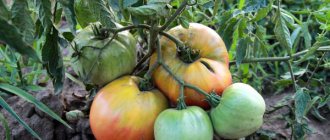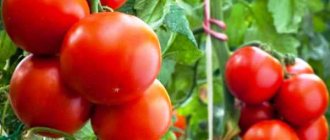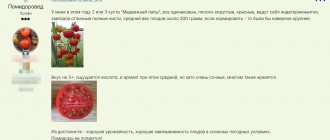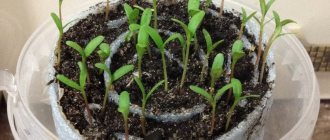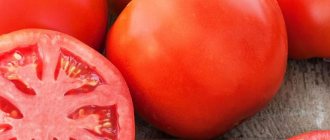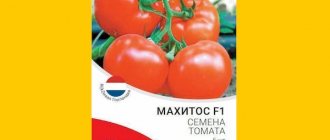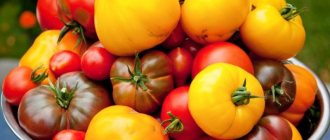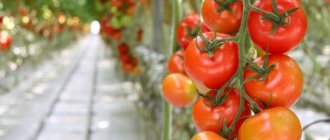Author's rating
Author of the article
Yakov Pavlovich
Professor, Head of the Department of Vegetable Growing
Articles written
153
Indoor soil partially smoothes out weather differences between regions. But there are many factors that influence the greenhouse microclimate: the length of daylight hours, the number of sunny days, the sum of active temperatures, air humidity and many others. Tomatoes for Siberia, even those growing in a greenhouse, must undergo the most stringent selection. The best varieties and hybrids have complex resistance to possible negative factors - cold and heat, sudden changes in temperature and humidity, fungal infections. Siberian greenhouse owners prefer early-ripening varieties and hybrids of tomatoes that are tall enough for efficient use of space.
Rules for selecting tomato varieties in cold climates
Greenhouse tomatoes for Siberia (large sweet varieties are a priority for gardeners) are the best option for growing in cold climates. Indoors it is easier to control watering and air temperature. However, due to the lack of a long and warm summer, crop varieties must be unpretentious and very early.
Tomatoes for Siberia are greenhouse tomatoes; large sweet varieties are chosen based on their survival rate: the higher it is, the better. Thanks to selection, specialists were able to develop excellent varieties for this region.
Tomatoes for Siberia - the best varieties
When purchasing seeds, pay attention to the following characteristics:
- The plants are not demanding on lighting, and the fruit ripening period is suitable for the short Siberian summer.
- Tomatoes grow well in areas with highly frozen soil.
- They are resistant to late blight.
It is worth choosing those varieties of tomatoes that were bred by breeders specifically for Siberia.
Good Siberian tomatoes without late blight
Late blight is a fungal disease that affects many varieties of tomatoes. The disease affects the entire plant, including the fruits. Hybrid tomatoes are considered the most resistant to late blight.
King of Siberia
Medium early variety of indeterminate type bush. The plant is at the stage of experimental cultivation. The tomato does not produce many sprouts. The base is formed from two stems. The leaf blade is slightly corrugated, small in size, dark green in color. The root shoots are powerful, strongly growing to the sides. The King of Siberia is a self-pollinating tomato.
korol-sibiri
Large-fruited tomatoes are heart-shaped, bright orange, weighing 500 - 800 grams. The peel is smooth and does not crack. The pulp is dense, plump, sweet in taste. The crop is frost-resistant, undemanding to moisture, and bears fruit consistently. Does not suffer from tobacco mosaic or late blight.
Snow Leopard
Medium early tomato, determinate type. In an open area it does not grow higher than 60 cm. The vegetable is red, dense, spherical, slightly flattened, weighing 120 - 150 grams. The pulp is plump, fleshy, with a sweet and sour taste. The harvest retains its taste and presentation for a long time. The risk of late blight is low. The variety is unpretentious. It features reliable yields even in the harshest conditions.
Snezhnyj-bars
Advantages of tomato varieties of Siberian selection
Greenhouse tomatoes for Siberia (large, sweet varieties are suitable for growing in a small area) have the following advantages:
- Productivity does not depend on the amount of nutrients in the soil.
Tomatoes for Siberia - growing in greenhouses
Tomatoes for Siberia - growing in greenhouses
- Rapid ripening in short summer conditions.
- Excellent taste of fruits obtained thanks to Siberian selection.
- Plant resistance to diseases characteristic of tomatoes.
- Highly resistant to temperature changes, even in regions with high moisture content.
- Do not need bright sunlight.
In addition, tomato varieties are suitable for canning and eating fresh.
How to choose the date for planting tomatoes in a greenhouse
There is no exact date for this operation in all parts of Siberia. You can determine the best time by taking into account several factors:
- Weather forecast;
- What was the climate like in previous seasons?
- Purchased tomato variety;
- Planting dates recommended by the manufacturer, indicated on the package of seeds;
- Condition and age of seedlings at the time of transplantation;
- Is it possible to regulate the soil temperature in the greenhouse?
The best early varieties for Siberia for greenhouses
It can be difficult to find greenhouse tomato varieties for Siberia. You can purchase seeds that produce large, sweet fruits in cold climates in online stores. The seller posts information about the variety, its characteristics and yield. In one click, the buyer will place an order and become the owner of valuable seeds.
Wonderful lady
The hybrid variety was obtained by Moscow breeders. The tomato is resistant to stressful weather conditions and has good taste. The trunk of the plant is large and dense, and the leaves of the plant are the same. The first cluster is tied above the 7th leaf, and after 1-2 inflorescences they alternate.
| Wonderful lady | |
| Growing conditions | Universal variety. It is recommended to plant no more than 3 plants per 1 m². The distance between rows is 50 cm. Planted no closer to each other than 50 cm. |
| Yield (kg/m²) | 13 outdoors, 15 in greenhouse. From 1 plant you can get up to 5 kg of harvest. |
| Boarding time | Seeds are planted for seedlings in mid-March. Grown plants are transferred to the greenhouse at 55-60 days. If planting in open ground, then add another 2-3 weeks to this time, and only then prepare for replanting. |
| Fruit harvest period | In open ground they ripen by 85-96 days from the time of planting, in a greenhouse - by the hundredth. |
| Description of tomatoes | Red tomatoes have dense flesh and strong skin. Easy to store or transport over long distances. Fruit weight – from 120 to 200 g. |
Tomatoes are suitable for canning. The fruits are resistant to Fusarium wilt, late blight and VMT. As the plant grows, it needs staking. The height of the stem ranges from 50 to 100 cm.
Lelya
The variety is mid-early, suitable for growing in open soil or in a greenhouse. Medium-sized and weakly branched plant. A fairly compact species, suitable for growing in a small area.
| Lelya | |
| Growing conditions | Seeds need to be illuminated with phytolamps. Hardening is carried out once a week at a temperature of +14°C. It is necessary to tie it to a support when the plant is actively growing. Requires partial stepsoning. Tolerates low light well and is cold-resistant. It is recommended to plant no more than 5 pieces per 1 m². It bears fruit better on sandy loam soil. Seedlings are picked when the plant produces 7-8 leaves. During the period of setting and flowering it needs feeding. |
| Yield (kg/m²) | From 12 to 15 in the spring-summer period, 14-18 - in the winter-spring period, in the summer-spring period - 8-9. |
| Boarding time | They are planted as seedlings 2.5 months before the desired planting in a permanent place of growth. |
| Fruit harvest period | 110 days from planting. |
| Description of tomatoes | Ripe red fruits weighing from 100 to 150 g. They have a sweet taste with a slight sourness. Suitable for preservation and fresh consumption. The skin is moderately tough, and the flesh is fleshy and juicy. Tomatoes are suitable for long-term fresh storage. |
During growth, the tomato needs to be looked after: remove weeds growing in the vicinity of the crop. The species itself is resistant to fusarium, tobacco mosaic virus, neck rot, root-knot nematode and cladosporiosis.
Bulat
A young hybrid variety belonging to the ultra-early ripening species. The plant has a maximum height of 1 m. 5-6 tomatoes ripen on one fruiting branch.
| Bulat | |
| Growing conditions | The species is suitable for cultivation in greenhouses and outdoors. After watering adult plants, the soil is loosened for good air exchange. During the growing season, to increase productivity, it is necessary to fertilize the soil. Tomato creeping is done once 15 days after planting young plants in a permanent place. After this, they are fed during the flowering and fruiting period. |
| Yield (kg/m²) | 15 |
| Boarding time | 1st ten days of April. If tomatoes are grown without seedlings, but directly into the ground, then its temperature should be at least +12°C. |
| Fruit harvest period | Fruit ripening begins on the 80th day from the start of planting the seeds. |
| Description of tomatoes | 1 fruit weighs from 80 to 120 g. The shape is round. Color – red. The peel has a high density, which makes the tomatoes suitable for transportation. The shell is not prone to cracks. The taste is pleasant, sweetish. |
Before planting in a permanent place of growth, seedlings need hardening. To do this, 2 weeks before transplanting, young plants are given air treatments at a temperature of +16°C.
Ground Gribovsky
Determinate tomato. The plant is semi-spreading, has an average number of leaf blades.
| Ground Gribovsky | |
| Growing conditions | During growth, the tomato does not need support or garter. There is also no need to shape the tomato, and as a result, there is no need to remove unnecessary stepsons. |
| Yield (kg/m²) | 3-5 in open ground and up to 8 in a greenhouse. A third of the crop ripens in the first 14 days after fruiting. |
| Boarding time | If planting is carried out in open ground, then the seedlings must be at least 50 days old. The air temperature should be +12°C. Seeds for seedlings begin to be planted at the end of February or beginning of March. |
| Fruit harvest period | 94-106 days after the start of planting. |
| Description of tomatoes | The fruits are not suitable for preservation. The weight of 1 tomato is from 60 to 100 g. The shape is round, red. |
Among gardeners, the Gribovsky ground variety is valued for its cold resistance, easy care and pleasant taste of the fruit.
Nice new items
All new species are even more resistant to pests and have a sweeter taste.
“Sevryuga” is quickly gaining popularity - a new product that amazes with the gigantic size of the fruit. One and a half kilograms is really a harvest, isn’t it? The bushes reach one and a half meters in height, have large, bright fruits with excellent taste. From one bush you will collect up to 5 kg.
"Eagle's Beak" - beautiful tomatoes with an unusual shape. This plant has thin, almost pendulous leaves, and the fruits themselves are pale and unattractive in appearance. But all this is just a first impression; the tomatoes are very sweet and tasty.
“Greek F1” is an early ripening hybrid with a spout, very tasty and good for pickling.
"Olesya" is the newest variety. The juice of such fruits is clearly reminiscent of apricot in both taste and color, contains a lot of carotene, and therefore is also very healthy. These are bright orange fruits with an unusual taste, grown mainly for pickling.
“Andreevsky Surprise” is still little known. The fruits are dark pink, 600 g each, few seeds. The bushes are particularly powerful, growing more than two meters - you will have to tinker with them in the greenhouse.
By the way, some varieties are good only for the table, and some are great only for pickling.
The most productive varieties for Siberia
Greenhouse tomatoes for Siberia (large, sweet fruits are always a priority) are in great demand due to their increased yield.
In this harsh climate, in order to get a decent amount of ripe and tasty tomatoes, you need to devote a lot of effort to garden crops. Therefore, those varieties that are unpretentious in care, but at the same time delight with abundant fruiting, are especially valued.
Scarlet candles
Tomatoes of this variety are tall and productive varieties. An adult plant forms a powerful bush up to 1.8 m high. When forming it, experienced gardeners advise leaving 2 stems. The advantage of Scarlet Candles is their excellent fruit set, regardless of the summer weather.
| Scarlet candles | |
| Growing conditions | Young plants dive when 2 leaves appear on the stem. No more than 4 plants are planted per 1 m². As the plant grows, its stem is tied up. Excess stepsons are removed no more than 2 times every 7 days. It is advisable to eliminate excess shoots before they grow more than 10 cm. Tomatoes are fed at least once a week. The plant grows better if it is mulched with straw or any other organic material. |
| Yield (kg/m²) | From 12 to 15 |
| Boarding time | 60-66 days before the desired planting to a permanent place of growth. For Siberia, the date for planting seeds is the end of March. |
| Fruit harvest period | The tomato begins to bear fruit 114 days after planting. The fruits can be collected for a long time - right up to the first frost. |
| Description of tomatoes | The fruits have the shape of an elongated, narrow cylinder with a “spout” at the end. During the ripening period, the color of tomatoes is pink. This is how he remains in his mature form. The weight of 1 fruit is 100 g. Suitable for fresh consumption and for preservation. The skin of tomatoes is moderately dense, smooth, and resistant to cracking. The pulp holds its shape well. |
The tomato variety is natural, and therefore the seeds of the ripe fruit can be left for planting next year. The plant is resistant to diseases: late blight, cladosporiosis, blossom end rot.
Samokhval
The variety is suitable for growing in greenhouses and open soil. It is a determinate species, of medium ripeness.
| Samokhval | |
| Growing conditions | Before seedlings, seeds are treated with a weak solution of potassium permanganate. It wouldn’t hurt to sprinkle them with growth stimulants. The planting depth should not exceed 1.5 cm. After planting, the seeds are watered using a spray bottle. For germination it is necessary to maintain a temperature of +/-24°C. Until the plants move to a permanent place of growth, they can be fed. After the shoots sprout, wait until the plant produces 2 leaves, and then the seedlings dive. They are transplanted into the greenhouse in mid-May. There are no more than 3 tomatoes per 1 m². An adult plant is tall - from 1.1 to 1.8 m. Because of this, the bush must be tied up or fixed to a support. It is necessary to carry out stepsoning. The first branch is laid above the 9th leaf, and subsequent brushes - after 2-3. |
| Productivity | 1 bush produces 5 kg of fruit. |
| Boarding time | 60-65 days before planting at a permanent place of growth. |
| Fruit harvest period | After 109-116 days from sowing. |
| Description of tomatoes | Large fruits weighing from 200 to 250 g. Shape - heart-shaped, yellow. The skin is smooth to the touch, the flesh is sweet, low in acids and high in carotene. |
The variety is resistant to necrosis, fruit rot and tomato mosaic. The advantage of the variety is its fertility. If you follow the recommendations of agronomists for cultivation, the weight of the fruit can reach 800 g. Tomatoes are suitable for canning, baby food or diet food.
Bull forehead
The variety was developed by Siberian breeders. The tomato is adapted to the West Siberian region. Belongs to determinant and mid-season species. The variety is capable of bearing fruit well even in unfavorable conditions. The height of an adult plant reaches 1.2 m.
| Bull forehead | |
| Growing conditions | During growth, tying and pinching is necessary. It bears fruit better if you form a bush with 2 stems. Per 1 m² - no more than 4 tomatoes. Loves watering. If possible, you can make a drip function. At the same time, it does not like overflow. During the ripening period, the tomato skin may crack due to excess moisture. The plant is fed with mineral complex fertilizers. Doesn't like weeds. Needs timely care to prevent diseases, especially from late blight. |
| Productivity | From 1 plant – 4-5 kg. From 1 m² - 18 kg. |
| Boarding time | 2 months before the desired planting in a greenhouse or open ground. Approximately the first or second ten days of March. If the plant grows in open ground, then the seedlings are transferred only when the risk of frost is minimized - late May or early summer. For greenhouses, this period can be reduced by a month. |
| Fruit harvest period | 115 days from the start of planting. |
| Description of tomatoes | Weight of 1 tomato - from 300 to 400 g. Under good growing conditions - up to 600 g. Shape - large, flat-round. When ripe it has a red color. Not suitable for long-term storage or transportation. It is recommended to eat immediately after collection or process or preserve. |
In cold regions, experts advise planting the plant in sunny areas.
Siberian surprise
The variety has proven itself to be capable of setting inflorescences even in unfavorable weather conditions. It is unpretentious, and therefore even inexperienced gardeners can cultivate it. But agronomists advise not to take risks in Siberian conditions and to grow it only in greenhouse conditions.
| Siberian surprise | |
| Growing conditions | Seedlings are watered once every 5 days. Seeds should be buried no more than 1 cm into the ground. There should be at least 16 hours of daylight in 1 day. Before planting in the ground, it is plowed with the addition of humus. During planting, add ash to the holes and water the recess. This should be done when frost is not possible. Grows well indoors or in a greenhouse. The height of an adult plant is 1.2 m. It is recommended to plant from 3 to 5 plants per 1 m². During growth, it is necessary to tie it up and take stepson. It performs better if you form 2-3 stems on the plant. |
| Productivity | From 1 bush to 9 kg. |
| Boarding time | 2.5 months before planting in the ground. Approximately January-April. |
| Fruit harvest period | They ripen from July to September. |
| Description of tomatoes | Fruit weight – 110-160 g. Shape – elongated cylinder. When ripe it is red. Great for canning or pickling. Also suitable for fresh consumption. |
The plant performed well during growth. Agronomists recommend caring for tomatoes in compliance with all recommendations, and then it will only show its best side.
Tomatoes for Siberia features and photos
Siberia is not the most successful region of the country for cultivating tomatoes. But every year the general availability of universal species increases. Breeders have developed special varieties that ripen in a short period, do not require lighting or constant care, and are resistant to natural conditions. There are many such types. Tomatoes differ in size and cultivation method.
tomatoes in open ground in Siberia
Subjectively bred varieties of tomatoes for Siberia for open ground are intended for cultivation in places where the ground freezes. The lack of nutrients in the soil mixture does not prevent the germination of vegetable crops. Tomatoes have features that are superior to other types. They ripen quickly, are unpretentious to sunlight and resistant to low temperatures. They are immune to infections and have excellent taste. High yield with small size.
Advice! Buy several varieties at once.
Growing a plant is not difficult, but follow the general care rules:
- The crop needs timely, abundant watering.
- To obtain a large harvest, tomatoes are fertilized with mineral fertilizers 3 times.
- Many tomatoes of Siberian selection are tied up.
- Prevent diseases and pests.
- Monitor the condition of the ground.
Taking into account the parameters, the best varieties of tomatoes for Siberia were found; we will study the description and photo further.
Low-growing greenhouse varieties
Caring for low-growing varieties is convenient because the plant requires less care and does not lose its productivity. This saves gardeners time and simplifies crop care.
Budenovka
Indeterminate variety of medium-growing type. Most often grown in greenhouses. It bears fruit for a long time, which allows harvesting for more than 2 months.
| Budenovka | |
| Growing conditions | Seedlings must be fed with organic or mineral fertilizers. Places for future permanent growth are dug up in the fall and ash, potassium salt and superphosphate are added to the soil. Plants grow better if the planting pattern is staggered, with a distance of 40 cm between plants. After planting, the tomatoes are tied up. Care, like any other crop, consists of moistening the soil, fertilizing and pinching. |
| Yield (kg/m²) | 20 |
| Boarding time | January March |
| The beginning of the harvest | After 95 days from the date of planting the seeds. |
| Description of fruits | The weight of the fruit depends on the type of cultivation - it ranges from 135 to 360 g. The shape is round, with an elongated lower part. The diameter of the tomato is 15 cm. Suitable for canning, processing into juice, ketchup or paste. |
The species is resistant to late blight, rot and diseases caused by fungi.
The Velvet season
Description:
| The Velvet season | |
| Description and growing conditions | Seeds for seedlings are soaked for a day in warm water. Then they should be treated with a weak solution of potassium permanganate. During cultivation, the air temperature is maintained at +24°C. Before planting in a greenhouse, the soil is disinfected and fertilizers are added to it. Picking is carried out when 2 leaves appear on the stem. 7-10 days before planting, young shoots are hardened off. They are transferred to the greenhouse when it is +19°C outside. No more than 4 plants are planted per 1 m². After 3 days, water. After 1.5 weeks, they put up supports and tie up the plant. After the first buds have formed, shoots are formed. Seedlings need regular fertilizers, the composition of which is alternated. The maximum height of the stem will be 50-60 cm. |
| Productivity | Per 1 m² gives 10 kg. One plant bears 3.5-5 kg of fruit. |
| Boarding time | 2 months before transferring the plant to a permanent place of growth. |
| The beginning of the harvest | 110 days after planting. |
| Description of tomatoes | They are red. Tomatoes with high sugar. The weight of 1 piece does not exceed 300 g. Suitable for pickling or salting. |
Olya
Description of the variety:
| Olya | |
| Cultivation conditions | The plant is not afraid of cold weather. Planted using the usual seedling method. Soil humidity – no more than 75% and no less than 70%. The plant does not like drafts. But it needs regular feeding, watering and loosening of the soil. It is necessary to form 1 stem on the tomato. Stepping is done only until the first brush is formed. No more than 7 plants are planted per 1 m². |
| Fruiting (kg/m²) | From 9 to 15 |
| Boarding time | 2 months before planting in a permanent place of growth. |
| The beginning of the harvest | On the 115th day from the date of planting the seeds. |
| Description of tomatoes | Fruit weight is from 100 to 160 g. The peel is medium thick, durable. When ripe it is red in color. They have good transportability. Suitable for canning and pickling. |
Pink honey
Description of the variety:
| Pink honey | |
| Description and how to grow | Suitable for cultivation in indoor greenhouses and outdoor substrate. It ripens among the first among similar varieties. The height of an adult plant does not exceed 1.5 m. The bush is formed with 1 or 2 stems. Has average resistance to diseases. Seedlings are picked when they grow 2 full leaves. Per 1 m² - plant no more than 4 plants. Loves systematic feeding and hydration. It is necessary to remove excess shoots, as well as carry out pest prevention. Loves the drip irrigation system. |
| Fruiting | From 1 bush – 6 kg |
| Boarding time | 2-2.5 months before transplanting into a greenhouse. |
| The beginning of the harvest | After 110 days from the date of planting the seeds. |
| Description of tomatoes | Weight - from 300 to 600 g. Sometimes tomatoes weighing 1 kg can ripen. The product is used for processing into juice, ketchup or sauce. Can be eaten fresh. The pulp is fleshy, sugary and sweet. |
How you can make the soil warm in a greenhouse for Siberia
The main task of garden owners in Siberia is to create warm soil in their greenhouse as early as possible. There are several ways to do this, the most common of which are:
- Heating the soil using underground water pipes, electrical cables, hot steam pipes, stove heating with a chimney, and other artificial heating methods. These are effective methods, but such soil heating will require significant financial costs;
- An inexpensive method is biological heating of the soil. To do this, dig a trench 0.5 meters deep. Organic residues from the garden, manure, straw, and unrotted compost are placed in it. The main thing is to use organic components that will decompose. When organic matter rots, a lot of heat is released, which will warm the soil in the greenhouse for a long time. The top of the filled trench is covered with soil with a layer of at least 40 cm; if there is a small layer of soil (less than 30 cm), the roots of the tomatoes will simply burn.
Important! A good result can be obtained if you plant tomatoes in cold Siberia in a greenhouse in bags with fertile soil and simply lay them on the ground. You can use tubs or boxes for planting; in extreme cases, make a raised bed - try to lift the roots of the plants above the ground surface by any means.
You can plant tomatoes in a wooden box; it is made in the fall and the required amount of nutritious soil is prepared. In the spring, organic components are poured into the bottom of the box, compacted well and covered with a layer of earth on top. After this, tomato seedlings are produced - the root system of the plants will be heated by decaying organic matter until all the organic matter rots.
Large-fruited varieties
Large-fruited varieties have a main drawback - due to their large fruits, they are practically unsuitable for preservation. Also, the bushes cannot bear fruit in large quantities. The clusters produce few fruits, but their small amount is compensated by their huge (by tomato standards) volume.
Alsou
Description of the variety:
| Alsou | |
| Growing conditions | The variety is resistant to diseases. Seeds require increased care. Air temperature for seedlings +25°C. It is necessary to provide good lighting for at least 15 hours a day. The seeds are pre-soaked for 1-2 hours. After drying (10-15 minutes), they are placed on a cloth soaked in a plate and left in this form until shoots appear for a couple of days. After this, they are dried and seated. Water with a spray bottle. When 4 leaves appear on the plant, it is transplanted into a separate container. Watering should be regular. Before moving to the greenhouse, the plants are hardened off. No more than 5 bushes per 1 m². The variety loves loosening the soil and mineral fertilizing. As it grows, the stem is tied up. Due to the large fruits, the brushes also need to be attached to a support. Air humidity in the greenhouse is not less than 30% and not more than 60%. |
| Fruiting (kg/m²) | Average – 8.5 |
| Boarding time | 2.5 months before transfer to the greenhouse |
| The beginning of the harvest. | On day 120 |
| Description of tomatoes | The fruits can easily be transported. The peel is not prone to cracking. Can be processed, canned or eaten fresh. |
Abakan pink
Description of the variety:
| Abakan pink | |
| Growing conditions | A tall plant, reaching a maximum height of 2 m. The stem is rather weak, with an average number of leaves. It and the branches with fruits are fixed to the support. Seedlings need to be hardened off before planting in the greenhouse. To do this, it is taken out into the fresh air or loggia for 2 weeks. The time of air baths is gradually increased to 30 minutes. The distance between seedlings in the garden bed is 50-60 cm. Form a bush with 2-3 stems. You can leave it unattended for a couple of days. During this time, the plant will not die. After transplanting into the soil, the tomato is watered abundantly, and the next moistening is done after 1-2 weeks. Then add water to the soil after 2-3 days. The plant loves organic fertilizers or potassium fertilizers. It is advisable to alternate them with nitrogen ones in the summer. The interval between procedures is 2.5 weeks. |
| Fruiting | From 1 m² 4 kg |
| Boarding time | 2.5 months before planting in the substrate. In the Siberian region and the Urals - mid-February or 1st decade of March. |
| The beginning of the harvest | 110-121 days after sowing |
| Description of tomatoes | From 215 to 550 g. The shape of the fruit is flat-round, sometimes heart-shaped. When ripe, the color is red or pinkish. The skin is thin, but at the same time resistant to cracking. The subcutaneous part is sugary and sweet. The vegetable is good for pickling or processing. |
King of Siberia
Description of the variety:
| King of Siberia | |
| Brief description of the variety | During growth, it is necessary to pinpoint and fix the plant to a support. The height of an adult tomato is 1.8 m. It gives the best harvest when no more than 2 stems are formed. No more than 4 plants are planted per 1 m². Loves timely watering, fertilizing and preventive measures. |
| Fruiting | From 1 plant on average 4.5 kg |
| Boarding time | 2.5 months before transferring plants to the greenhouse |
| The beginning of the harvest | 120 days after seedlings |
| Description of tomatoes | From 300 to 600 g. Suitable for diet, allergy sufferers. Can be recycled. Due to their large volume, they are difficult to preserve. The shape of the tomato is round, elongated towards the bottom. Yellow color. |
Grandma's secret
Description of the variety:
| Grandma's secret | |
| Growing conditions | A mid-season variety that produces a good harvest. The bushy plant reaches a height of 1.7 m. It is necessary to tie up the trunk as it grows. The variety needs to be stepsoned. Fruits best when 1-2 stems are formed. No more than 4 plants are planted per 1 m². It has low resistance to late blight, and therefore regular prevention of this and other tomato diseases should be carried out. All leaves growing below the ovaries should be removed for this purpose. |
| Fruiting | From 1 bush – 5 kg |
| Boarding time | 2.5 months before planting in the ground |
| The beginning of the harvest | 110 days after planting |
| Description of tomatoes | The weight of 1 fruit is from 310 to 650 g. The shape is round, red-colored. The pulp is juicy and has good taste. The variety is suitable for preparing or eating fresh. The large volume of fruits often causes them to crack near the stem. |
Late blight resistant varieties
The main advantage of hybrid tomatoes, combined with their good yield, is their resistance to many diseases. Thus, breeders have developed varieties that are not susceptible to late blight. These types of crops have become favorites among agronomists.
Kostroma
Description of the variety:
| Kostroma | |
| Growing conditions | The best harvest will be obtained if the plant is left with 1 stem. Belongs to an early-ripening, semi-determinate species. The height of an adult bush is 2 m. Watering is done as the soil dries out. Regular fertilizing with fertilizers and minerals. |
| Fruiting | From 1 bush to 5 kg |
| Boarding time | 2 months before transferring the seedlings to the greenhouse |
| The beginning of the harvest | On the 103rd day from the day of sowing |
| Description of tomatoes | Weight of tomatoes - from 84 to 146 g. The shape is flat-round, bright red. It is used both in conservation and for fresh consumption. |
Kohawa
Description of the variety:
| Kohawa | |
| Growing conditions | Hybrid plant, determinate. Before planting, seeds are treated with a weak solution of potassium permanganate. They are buried in the ground to a depth of no more than 2 cm. They are planted after the appearance of 1 leaf on the shoot. During growth, it is necessary to systematically water and feed the seedlings. No more than 3 plants are sown per 1 m². |
| Fruiting (kg/m²) | 9 kg |
| Boarding time | 1.5-2 months before transferring seedlings to the greenhouse |
| The beginning of the harvest | 87 days after sowing |
| Description of tomatoes | The shape of the fruit is round. Weight 140 g. The color of the tomatoes is bright red. Suitable for transportation. The skin does not crack. Suitable for pickling or eating fresh. |
Titanic
Description of the variety:
| Titanic | |
| Growing conditions | The plant is mid-early, compact. Propagated by seedling method. Before planting, the vegetable crop is hardened off at a temperature of 16°C. There are 4 bushes per 1 m². In adult form it does not exceed 65 cm. The bush is weakly branched with simple inflorescences. No more than 6 tomatoes ripen on one branch. The variety is resistant to diseases. Tolerates changes in air painfully. Doesn't like drought. Needs loosening, pinching, tying, weed removal, and fertilizing. |
| Fruiting (kg/m²) | 10-15 |
| Boarding time | January March |
| Beginning of fruiting | 110 days after sowing |
| Description of tomatoes | The shape is round. Vegetables are deep red. The subcutaneous part is sweet, weighing no more than 250 g. It can be stored for a long time. Suitable for pickling or processing. The fruits are often pickled. |
Bersola
An early variety of tomato. It is stress resistant to air changes. Tomato skin is resistant to cracking. To get an early harvest, the plant must be cultivated in greenhouses or indoors.
| Bersola | |
| Growing conditions | Vegetables are grown in greenhouses or closed ground. The variety is suitable for spring-summer rotation. Determinate plant that does not require special care. |
| Fruiting (kg/m²) | From 7.2 to 8 |
| Boarding time | 1.5-2 months before planting in the substrate |
| The beginning of the harvest | 3 months after sowing |
| Description of tomatoes | Vegetable weight +/- 160 g. The shape is round, slightly flattened, red. Sometimes the tomatoes may be slightly yellowish on the outside, but the flesh is pink. Vegetables are suitable for salads and simple eating. |
The variety is resistant to mosaic virus, nematodes, verticillium wilt, and cladosporiosis.
Standard low-growing ones for Siberia for open ground
The region has a fairly cold climate, but the breeders of our country do not stand still; they managed to develop high-yielding Siberian tomatoes, which are cultivated in such natural conditions. Standard species bear fruit well and produce an impeccable harvest when cultivated in open areas.
Buyan (Fighter)
The bush is low 40 - 45 cm, standard, determinate in appearance. The leaves are medium in size, dark in color, slightly wrinkled. Tomatoes ripen 95 days after germination of seedlings, weighing 65 - 90 grams. The tomato is purple in color and oblong in shape. It has a smooth surface, thick skin, and juicy pulp. Tomatoes are consumed fresh and salted. The variety is drought-resistant, this is a big plus for agricultural technicians who cannot moisten the crop in a timely manner.
boec
Note! Another name for tomatoes is indicated on packages of planting material - Buyan.
Nevsky
The early ripening crop is very small in stature (30 – 50 cm). The ripening time of berries is 90 – 100 days. The variety is undemanding, there is no need to tie it up. Ripe fruits are small, spherical, crimson in color, weight 45 - 55 g. Tomatoes have excellent taste and a long shelf life.
The plant is resistant to many infections. Easily tolerates lack of moisture. Among the main advantages of tomato is the ability to cultivate in urban conditions. But there are some disadvantages: low yield, demanding fertilizers.
For pickling
Tomatoes are well suited for pickling; they allow you to preserve the harvest without losing its taste. However, not all varieties of tomatoes are suitable for this: some crack, others lose their shape. Therefore, if vegetables are grown for preservation purposes, appropriate varieties are chosen.
Greek
A productive hybrid with good yield characteristics. The variety is indeterminate and reaches a height of 180 cm when mature.
| Greek | |
| Growing conditions | During planting, seeds are buried in the soil to a depth of 1 cm. They are planted when the plant produces 2 leaves. Seedlings are fed no more than 3 times with fertilizers. 10 days before the start of transfer to a permanent place of growth, the shoots begin to harden. Planting pattern: 30x50 cm. Water the tomatoes after sunset. |
| Fruiting (kg/m²) | 7,7 |
| Boarding time | End of March, first ten days of April |
| The beginning of the harvest | On the 95th day from the day of sowing |
| Description of tomatoes | Fruit weight is from 120 to 160 g. Shape – oval, elongated with a spout. The skin is smooth. |
The variety is not prone to fusarium disease. When ripe, under cool conditions, tomatoes are stored well until November.
Olesya
Frost-resistant type of tomatoes belonging to mid-season varieties. It is unpretentious in care - it is enough to follow the recommendations of agronomists in order to have a good harvest. Tomatoes are similar in taste to fruits, and therefore children really like them.
| Olesya | |
| Growing conditions | Seedlings are plucked after the emergence of 2 leaves on each plant. The air temperature is maintained at +25°C. The seedlings are fed 2 times with mineral fertilizers. To increase immunity, seedlings need regular ventilation and hardening. In adult form, the tomato is tall, up to 1.8 meters high. Requires support and garters, pinching. To get a good harvest, 2 stems are formed. No more than 4 plants are planted per 1 m². The distance between tomatoes is 40-50 cm. Moderate watering is required. Before planting in a permanent growth site, the soil is fertilized with phosphorus, nitrogen and potassium. |
| Fruiting (kg/m²) | 4,7 |
| Boarding time | From January to March |
| The beginning of the harvest | On the 103-120th day from the date of planting (July-September) |
| Description of tomatoes | The shape of the fruit is oval-plum, orange in color. Weight – from 120 to 200 g. The subcutaneous part is fleshy and sweet. The taste of the juice from this tomato is similar to that of apricot. The vegetable can be eaten fresh and pickled. However, many gardeners note that when rolled into jars, the skin of the fruit often bursts. |
The variety gives a good harvest if the plant is watered regularly, drafts are prevented in the greenhouse and, if possible, the soil is mulched.
Koenigsberg
The variety of this tomato was bred by breeder from Siberia V.N. Dederko. The tomato is not a hybrid and is suitable for cultivation in greenhouses and open ground.
| Koenigsberg | |
| Growing conditions | The sprouts sprout after 2 leaves appear on them. At a permanent growth site, place no more than 3 tomatoes per 1 m². An adult plant reaches a height of 2 m. The stem is powerful with a moderate number of leaves. It needs to be tied up and pinched. Gives a good harvest with 1-2 stems. Requires complex mineral fertilizers and regular prevention from pests and diseases. |
| Yield (kg/m²) | 20 |
| Boarding time | 2 months before planting in the ground (January-March) |
| Fruit harvest period | From July to September. Fruit ripening begins 100 days after planting. |
| Description of tomatoes | Fruit weight is from 250 to 310 g. Shape - cylindrical, red. Can be used fresh and for canning. |
The seeds of an already ripe tomato can be used to grow this plant next year.
Sabelka
Tomatoes are an indeterminate species. They are distinguished by tall stem growth with corrugated and large leaf plates.
| Sabelka | |
| Growing conditions | Seeds for seedlings are planted in a substrate of peat, sand and humus. The mixture is first shed with a weak solution of potassium permanganate. You can also soak them in it for 13 minutes. To reduce the acidity of the soil, wood ash is additionally added to it. The air temperature for seedlings should be +24°C. The plant is fed 5 times: 2 during seed growth and 3 already in its adult state. Watering is carried out only with warm water. |
| Yield (kg/m²) | 6-7 |
| Boarding time | 2 months before the desired transplant to a permanent place of growth. |
| Fruit harvest period | 120 days from the start of sowing |
| Description of tomatoes | The shape of the fruit is cylindrical, red in color when ripe. The weight of 1 tomato is from 100 to 120 g. The taste of the pulp is good, sweet. Suitable for fresh consumption, for salads, and also for preservation. |
Regardless of the variety, tomatoes for Siberia show a good harvest only if all agricultural practices are followed. Greenhouse crops are capable of producing large and sweet fruits even in a changeable climate. But this does not mean that plants can be left to their own devices. They will still need basic watering and weeding.
Reviews from gardeners
Larisa: “Of all the varieties of tomatoes, I know and grow the Heavy of Siberia. The tomatoes are large, plump, sweet. This is the fifth year they’ve been planting and they’ve never upset us.”
Anatoly: “I plant Scarlet Candles according to a thickened planting pattern with a spacing of 25 cm. The bush produces 10 fruit clusters, regardless of the weather. The tomatoes are sweet, I use them in salads, can them, and process them for the winter.”
Valentina: “This summer I cultivated Biysk rose in open ground. The bush is low but powerful. It grows quickly, tied and took stepson. There were a lot of ovaries, the harvest was excellent. The tomato is tasty, sweet, with fleshy pulp. I add it to salads and process it for the winter. I liked the tomato, they are already cultivating seedlings.”
